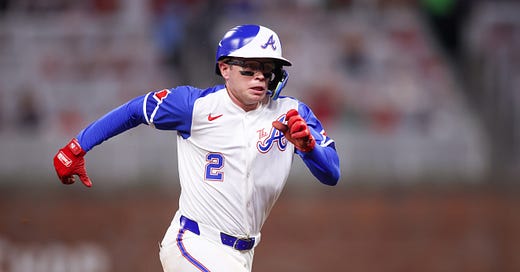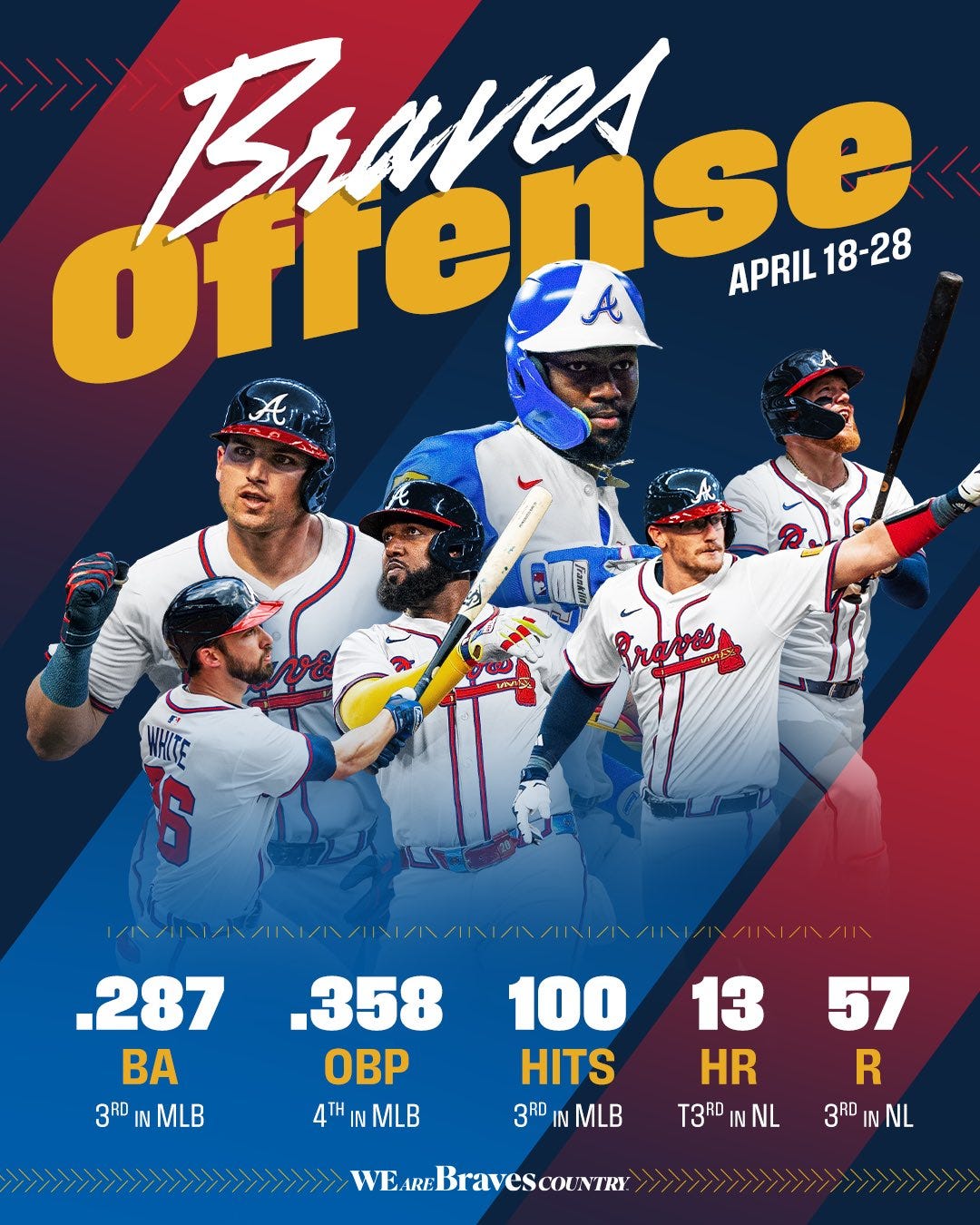Nick Allen's offensive improvements aren't sustainable but that's okay
Allen's making an impact at the bottom of the order, but let's not count on it happening all season once the Regression Monster has its way
The Atlanta Braves posted a graphic on X/Twitter on Tuesday morning, crowing about the team’s offensive ranks over the last few weeks.
Starting on April 18th, the start of the team’s six game homestand against the Minnesota Twins and St. Louis Cardinals, the Braves offense was either one of the best in the National League or in baseball at several offensive metrics, including the 3rd-best batting average in all of baseball at .287, the 4th-best on-base percentage at .358, and 3rd-best in the NL marks for home runs (13) and runs scored (57).
As I pointed out when the tweet went up, the start date coincided with the installation of Alex Verdugo as the team’s leadoff hitter and left fielder.
Another lesser-heralded change was the installation of Eli White and Nick Allen in the right field and shortstop spots. The duo, paired predominantly with Michael Harris II or Drake Baldwin at the bottom of the order, has fueled Atlanta’s lineup to a 9-2 record during that span, frequently getting on base and being driven in by the heart of the order.
While White’s torpedo bat-fueled breakout feels real, Allen’s made it happen with some luck and is due for regression. Let’s talk about it.
His offense has never been THIS good
Heading into 2025, Allen’s previous career-best offensive marks were in 2023, putting up a .221 average and a .550 OPS, good for a 56 OPS+.
Entering Tuesday night, he was hitting .292 with a .691 OPS and picked up a run and two more RBI in the 4th inning.
Whenever a guy hits a new level of production, there’s a few things to look for. Let’s detail them and figure out what’s resulting in the heater he’s on.
Possibility: Some sort of mechanical or approach change
There are a few small things here, but nothing that would explain a breakout. He’s moved a bit closer in the box from last season with the Athletics to this year with the Braves, but that’s mostly manifesting by…not being quite so deep in the box. With Oakland, he was literally as far back as legally allowed, having a depth in the box of 27.4”. This year, that’s shifted up a bit to 26.9”, and while he’s gotten closer to the pitcher, he’s also about two-tenths of an inch farther away from the plate.
While it’s possible that being a little closer to the pitcher is helping him put up a career-high 27.7% pull rate, it’s less than 4% improved from last season and not enough to explain a massive improvement in his results. There’s got to be something else.
Possibility: Overperformance of his inputs
There you go.
Let me give you the breakdown of his actual versus his expected statistics through 71 plate appearances entering Tuesday’s action:
BA = .292, xBA = .243
wOBA1 = .320, xwOBA = .273
SLG = .338, xSLG = .291
Most of the overperformance in Allen’s batted ball profile comes down to the lack of power for him - his average exit velocity of 84.9 mph is only 4th percentile, he doesn’t have a single barrel on the season and only a 15th percentile hard-hit rate of 30.4%.
While someone with Allen’s speed will always slightly outperform the league average BABIP of .258, Allen’s .404 BABIP is well above even what an absolute burner could be expected to produce and is likely to regress, as well.
While Allen likely won’t end up falling all the way back to being a .209 hitter like he was before coming to Atlanta, that .292 is likely to drop to the .240-.250 range.
Everything else Allen does is ELITE
But honestly, Allen could bat .220 and I’d be happy because he’s legitimately elite at every other aspect of the game.
Allen’s one of the league leaders in Fielding Run Value at +4, a 98th percentile mark, despite having fewer innings in the field (169 entering Tuesday night) than every player ahead of him on the list.
And there aren’t many players ahead of him, either - Allen’s +4 mark is tied with 3B Ke’Bryan Hayes, CF/2B Tommy Edman, and 2B Otto Lopez for the 3rd best mark among all defenders in baseball. Allen is the top-rated shortstop by Defensive Run Value in all of baseball, outperforming Jeremy Pena of the Astros (+3 Run Value) despite Pena having 81 more innings than him.
Most of that value comes from Allen’s range, coming in at +5 OAA, a 99th percentile mark in the entire sport and the top mark for any shortstop. He excels in virtually every direction, getting +3 on plays to his right, +1 on plays to his left, and +1 when backing up into shallow left field to make plays. (He’s neutral on plays where he needs to charge a ball.)
His arm strength actually isn’t that great, coming in at a below-average 43rd percentile mark of 82.7 mph. That’s 80th among 144 qualified defenders (50 throws). While a strong throwing arm isn’t a prerequisite to being a good defender - Dansby Swanson won a Gold Glove last year with a 30th percentile arm strength figure of 81.3 mph - it definitely helps cover up for misplays and nab the faster runners.
But it’s not just the defense where Allen excels; he’s also making an impact on the basepaths.
He’s one of the best baserunners on the roster
Allen’s not the fastest player on the roster, coming in at a 63rd percentile 27.8 ft/sec (5th on the team2), but he’s tied with Michael Harris for first in added value at +1 Baserunning Run Value. They’re both sitting at the 89th percentile in MLB; most players are at zero or negative this early in the season.
I’ve got Harris above Allen simply because Allen’s been caught stealing twice in six total attempts, but he’s also contributed additional runs via taking extra bases on hits and hasn’t been thrown out on a single one of those attempts.
It doesn’t need to be said, but all of this is in sharp contrast to Orlando Arcia, who once steady defense has deteoriated in his limited playing time this season (-1 Fielding Run Value in just 74 innings at shortstop) and his baserunning has always been impacted by his bottom-of-the-barrel sprint speed of 24.5 ft/sec (6th percentile).
Even if the offense does back off, like I expect it to, Allen has multiple years of team control as a high-contact bat with exceptional defense and speed. It’s more than a sufficient bridge to the next wave of shortstops working up through the lower minors like John Gil and Ambioris Tavarez.
wOBA, pronounced “woah buh”, stands for Weighted On-Base Average and is a derivative of on-base percentage that accounts for how players reached base, understanding that a homerun is more valuable than a walk or single using the projected run totals of each type of hit. xwOBA, the expected version of wOBA, uses launch angle, exit velocity, and your sprint speed for types of batted balls where that matters to calculate the expected wOBA for any given batted ball.
Eli White at 29.9 ft/sec, Michael Harris at 28.2, Austin Riley at 28.1, Ozzie Albies at 27.8, & then Allen at 27.6.





You teased Eli White's breakout feeling real. Want to expand upon that in a follow-up article? :)